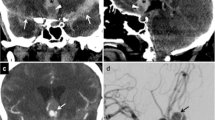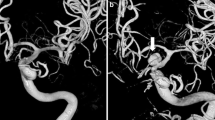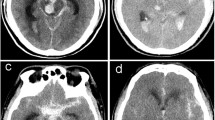Abstract
Introduction
The aim of this study was to compare flat-panel volumetric CT (VCT) to conventional CT (cCT) in the visualization of the extent of subarachnoid hemorrhage (SAH) and the width of the ventricles in patients with acute SAH.
Methods
Included in the study were 22 patients with an acutely ruptured cerebral aneurysm who received VCT during coil embolization. VCT image quality, the extent of SAH (using a modified Fisher score and total slice number with SAH visible) and the width of the ventricles (Evans index) were evaluated by two experienced neuroradiologists (RAD1 and RAD2) and compared to the findings on cCT. Ten patients undergoing VCT for reasons other than SAH served as negative controls.
Results
Interobserver agreement in rating image quality was excellent for cCT (Kendall W value 0.94) and good for VCT (0.74). SAH was identified by RAD1 and RAD2 on VCT images in all patients. The modified Fisher scores underestimated the extent of SAH on VCT images in comparison with cCT images. Pearson’s correlation coefficient (r) regarding the number of image slices with SAH visible on cCT images compared with the number on VCT images was 0.85 for RAD1 and 0.84 for RAD2. The r value for the degree of interobserver agreement for the number of slices with SAH visible was 0.99 for cCT, and 0.95 for VCT images (n = 19), respectively. The width of the ventricles measured in terms of the Evans Index showed excellent concordance between the modalities (r = 0.81 vs. 0.82).
Conclusion
Our preliminary results indicate that VCT is helpful in evaluating SAH in the angiography suite. Additionally, reliable evaluation of ventricle width is feasible. However, there are limitations with regard to the visibility of SAH on VCT images in comparison to cCT images.





Similar content being viewed by others
References
Molyneux AJ, Kerr RS, Yu LM, Clarke M, Sneade M, Yarnold JA, Sandercock P (2005) International subarachnoid aneurysm trial (ISAT) of neurosurgical clipping versus endovascular coiling in 2143 patients with ruptured intracranial aneurysms: a randomised comparison of effects on survival, dependency, seizures, rebleeding, subgroups, and aneurysm occlusion. Lancet 366:809–817
Brisman JL, Niimi Y, Song JK, Berenstein A (2005) Aneurysmal rupture during coiling: low incidence and good outcomes at a single large volume center. Neurosurgery 57:1103–1109
Gupta R, Grasruck M, Suess C, Bartling SH, Schmidt B, Stierstorfer K, Popescu S, Brady T, Flohr T (2006) Ultra-high resolution flat-panel volume CT: fundamental principles, design architecture, and system characterization. Eur Radiol 16:1191–1205
Schumacher M, Kutluk K, Ott D (1989) Digital rotational radiography in neuroradiology. AJNR Am J Neuroradiol 10:644–649
Hatakeyama Y, Kakeda S, Korogi Y, Ohnari N, Moriya J, Oda N, Nishino K, Miyamoto W (2006) Intracranial 2D and 3D DSA with flat panel detector of the direct conversion type: initial experience. Eur Radiol 16:2594–2602
Kalender WA (2003) The use of flat-panel detectors for CT imaging. Radiologe 43:379–387
Loose R, Wucherer M, Brunner T, Adamus R, Simmler R (2005) Visualization of 3D low contrast objects by CT cone-beam reconstruction of a rotational angiography with a dynamic solid body detector. Rofo S1, PO 160
Heran NS, Song JK, Namba K, Smith W, Niimi Y, Berenstein A (2006) The utility of DynaCT in neuroendovascular procedures. AJNR Am J Neuroradiol 27:330–332
Buhk JH, Elolf E, Knauth M (2006) Angiographic computed tomography is comparable to multislice computed tomography in lumbar myelographic imaging. J Comput Assist Tomogr 30:739–741
Fisher CM, Kistler JP, Davis JM (1980) Relation of cerebral vasospasm to subarachnoid hemorrhage visualized by computerized tomographic scanning. Neurosurgery 6:1–9
Synek V, Reuben JR, Du Boulay GH (1976) Comparing Evans’ index and computerized axial tomography in assessing relationship of ventricular size to brain size. Neurology 26:231–233
Benndorf G, Strother CM, Claus B, Naeini R, Morsi H, Klucznik R, Mawad ME (2005) Angiographic CT in cerebrovascular stenting. AJNR Am J Neuroradiol 26:1813–1818
Benndorf G, Claus B, Strother CM, Chang L, Klucznik RP (2006) Increased cell opening and prolapse of struts of a neuroform stent in curved vasculature: value of angiographic computed tomography: technical case report. Neurosurgery 58(4 Suppl 2):ONS–E380
Akhtar M, Vakharia KT, Mishell J, Gera A, Ports TA, Yeghiazarians Y, Michaels AD (2005) Randomized study of the safety and clinical utility of rotational vs. standard coronary angiography using a flat-panel detector. Catheter Cardiovasc Interv 66:43–49
Zellerhoff M, Scholz B, Ruehrnschopf EP, Brunner T (2007) Low contrast 3D reconstruction from C-arm data. Proc SPIE 5745:646–655
Suzuki S, Furui S, Kobayashi I, Yamauchi T, Kohtake H, Takeshita K, Takada K, Yamagishi M (2005) Radiation dose to patients and radiologists during transcatheter arterial embolization: comparison of a digital flat-panel system and conventional unit. AJR Am J Roentgenol 185:855–859
Schueler BA, Kallmes DF, Cloft HJ (2005) 3D cerebral angiography: radiation dose comparison with digital subtraction angiography. AJNR Am J Neuroradiol 26:1898–1901
Conflict of interest statement
We declare that we have no conflict of interest.
Author information
Authors and Affiliations
Corresponding author
Rights and permissions
About this article
Cite this article
Doelken, M., Struffert, T., Richter, G. et al. Flat-panel detector volumetric CT for visualization of subarachnoid hemorrhage and ventricles: preliminary results compared to conventional CT. Neuroradiology 50, 517–523 (2008). https://doi.org/10.1007/s00234-008-0372-z
Received:
Accepted:
Published:
Issue Date:
DOI: https://doi.org/10.1007/s00234-008-0372-z




